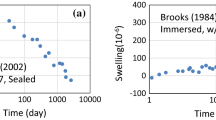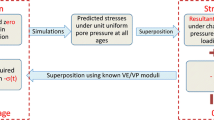Abstract
As concrete cures in the field, there is a constant competition for the mixing water between evaporation and hydration processes. Understanding the mechanisms of water movement in the drying/hydrating cement paste is critical for designing curing systems and specialized rendering materials, as well as for selecting repair materials and methodologies. In this work, X-ray absorption measurements indicate that fresh cement paste dries uniformly throughout its thickness, as opposed to exhibiting the sharp drying front observed for most porous materials. Furthermore, in layered composite cement paste specimens, water always flows from the coarser-pore layer to the finer one, both when coarser pores are produced by using an increased water-to-cement ratio (w/c) and when they are present due to using a cement with a coarser particle size distribution at a constant w/c. Conversely, no clear differential water movement is observed between layers of cement paste and mortar of the same nominal w/c. Based on the results of these experiments, drying has been introduced into the NIST CEMHYD3D cement hydration and microstructure development model, by emptying the largest water-filled pores present at any depth in the model specimen at a user-specified (drying) rate. With this addition, the CEMHYD3D model produces results in good agreement with experimental observations of both the drying profiles and the hydration kinetics of thin cement paste specimens.
Résumé
Lors de la cure du ciment sur chantier, la réaction d'hydratation est en constante compétition avec l'évaporation. La compréhension des mécanismes de mouvements d'eau au sein de la pâte en cours de séchage/hydration est essentielle non seulement en vue de déterminer des méthodes de cure adaptées et de développer des mortiers spéciaux, mais également en vue de sélectionner les bons produits et les bonnes méthodologies de réparation. Dans ce travail, les mesures d'absorption des rayons X mettent en évidence que la pâte de ciment sèche de façon uniforme sur toute son épaisseur, et non selon un front marqué comme on peut couramment l'observer dans les matériaux poreux. De plus, dans le cas de pâte de ciment bi-couche, les mouvements d'eau se font toujours de la couche contenant les pores de taille la plus importante vers celle contenant les pores les plus fins, que les pores grossiers soient dus à un rapport e/c élevé ou à une granulométrie grossière des particules de ciment. À l'inverse, aucun mouvement d'eau n'est observé entre couches de pâte de ciment et de mortier à rapport e/c constant. Sur la base de ces résultats, le séchage a été introduit dans le modèle d'hydratation et de développement de la microstructure du ciment CEMHYD3D développé par le NIST. Les pores saturés d'eau de tailles les plus importantes sont ainsi vidés selon une cinétique fixée par l'opérateur, ceci quelle que soit leur position dans l'épaisseur de l'échantillon. CEMHYD3D génère ainsi des résultats présentant une bonne corrélation avec les observations expérimentales, en terme de profils de séchage et de cinétiques d'hydratation, réalisées sur des pâtes de ciment de faible épaisseur.
Similar content being viewed by others
References
Meeks, K. W. and Carino, N. J., ‘Curing of High-Performance Concrete: Report of the State-of-the-art’, NISTIR 6295, U.S. Department of Commerce, March 1999.
Griesel, E. J. ‘The influence of controlled environmental conditions on the potential durability of concrete’, M. S. Thesis, University of Stellenbosch, South Africa, April 1999.
Vallée, F., Lejeune, C. and Cope, R., ‘Investigation of the evolution of a thin layer cement paste microstructure during climatic exposures’ submitted toCem. Concr. Res., 2000.
Vallée, F., ‘Durabilité des composites polymères/ciment: Application au cas des enduits minces sur isolants’, Ph.D. thesis, Institut National Polytechnique de Grenoble, France, October 1999.
Hansen, K. K., Jensen, S. K., Gerward, L. and Singh, K., ‘Dual-energy X-ray absorptiometry for the simultaneous determination of density and moisture content in porous structural materials’, in ‘Proc. of the 5th Symposium on Building Physics in the Nordic Countries’, (Chalmers University of Technology, Gothenburg, Sweden, 1999) 281–288.
Bentz, D. P., ‘Three-dimensional computer simulation of cement hydration and microstructure development’,J. Amer. Ceram. Soc. 80 (1) (1997) 3–21.
Bentz, D. P., ‘CEMHYD3D: A three-dimensional cement hydration and microstructure development modelling package. Version 2.0’, NISTIR 6485, U.S. Department of Commerce, April 2000, available at http://ciks.cbt.nist.gov/monograph.
Bentz, D. P. and Hansen, K. K., ‘Preliminary observations of water movement in cement pastes during curing using X-ray absorption’,Cem. Concr. Res. 30 (2000) 1157–1168.
Madsen, H. M., ‘Hydration and drying in cement pastes measured with X-ray’, M.S. Thesis, Technical University of Denmark, Lyngby, Denmark, February 2000, (in Danish).
Cement and Concrete Reference Laboratory Proficiency Sample Program: Final Report Portland Cement Proficiency Samples Number 133 and Number 134, Cement and Concrete Reference Laboratory, September, 1999.
Bentz, D. P., Jensen, O. M., Hansen, K. K., Olesen, J. F., Stang, H. and Haecker, C. J., ‘Influence of cement particle size distribution on early age autogeneous strains and stresses in cement-based materials’,J. Amer. Ceram. Soc. 84 (1) (2001) 129–135.
Bentz, D. P., Snyder, K. A. and Stutzman, P. E., ‘Microstructural modelling of self-desiccation during hydration’, in ‘Self-Desiccation and Its Importance in Concrete Technology’, Ed. B. Persson and G. Fagerlund (Lund Institute of Technology, Lund Sweden, 1997) 132–140.
Bentz, D. P., ‘Effects of cement PSD on porosity percolation and self-desiccation’, in ‘Self-Desiccation and Its Importance in Concrete Technology II’, Ed. B. Persson and G. Fagerlund (Lund Institute of Technology, Lund, Sweden, 1999) 127–135.
Coussot, P., private communication, 1999.
Selih, J., Sousa, A. C. M. and Bremner, T. W., ‘Moisture transport in initially saturated concrete during drying’,Transport in Porous Media 24 (1996) 81–106.
Coussot, P., Gauthier, C., Nadji, D., Borgotti, J.-C., Vie, P. and Bertrand, F., ‘Mouvements capillaires durant le séchage d'une pâte granulaire’, C.R. Acad. Sci. (Paris), t. 327, Serie IIb (1999) 1101–1106.
Bentz, D. P. and Garboczi, E. J., ‘Computer modelling of interfacial transition zone microstructures and properties’, in ‘Engineering and Transport Properties of the Interfacial Transition Zone in Cementitious Composites’, Ed. M. G. Alexander, G. Arliguie, G. Ballivy, A. Bentur and J. Marchand (RILEM, Paris, France, 1999) 349–385.
Taylor, H. F. W., ‘Cement Chemistry’, (Thomas Telford, London 1997).
Weber, S. and Reinhardt, H. W., ‘Manipulating the water content and microstructure of high performance concrete using autogenous curing’, in ‘Modern Concrete Materials: Binders, Additions, and Admixtures’, Ed. R. K. Dhir and T. D. Dyer (Thomas Telford, London, 1999) 567–577.
Bentz, D. P. and Snyder, K. A., ‘Protected paste volume in concrete: extension to internal curing using saturated lightweight fine aggregate’,Cem. Conr. Res. 29 (11) (1999) 1863–1867.
Author information
Authors and Affiliations
Additional information
Editorial Note Mr. Dale P. Bentz is a RILEM Senior Member. He works at the NIST (USA), a Titular Member. He is also a Member of RILEM Coordinating Committee and was awarded the Robert L'Hermite medal in 1998. CSTB (France) is a RILEM Titular Member
Rights and permissions
About this article
Cite this article
Bentz, D.P., Hansen, K.K., Madsen, H.D. et al. Drying/hydration in cement pastes during curing. Mat. Struct. 34, 557–565 (2001). https://doi.org/10.1007/BF02482182
Received:
Accepted:
Issue Date:
DOI: https://doi.org/10.1007/BF02482182




